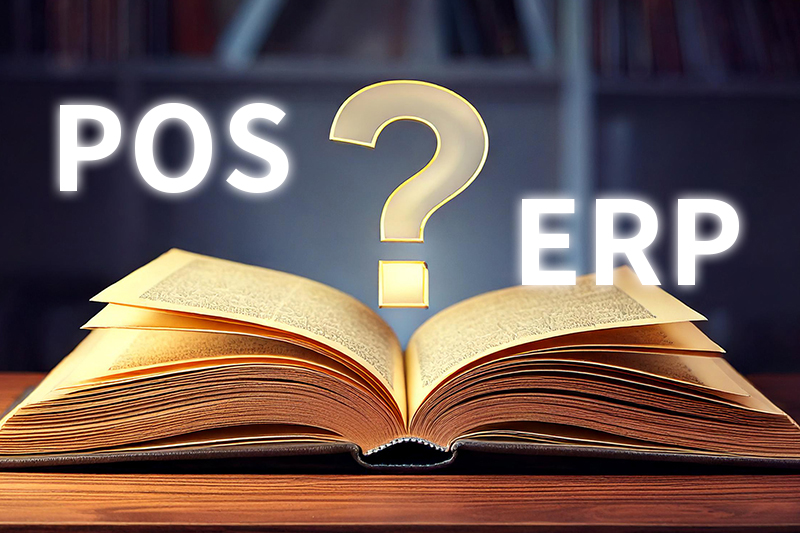
What is ERP System?
ERP system integrates core business processes, consolidating various departmental workflows into a comprehensive information system. It can be broadly categorized into “Financial Accounting,” “Human Resources,” “Manufacturing,” and “Inventory Management.”
Depending on different industry needs, additional module functionalities such as “CRM (Customer Relationship Management),” “POS (Point of Sale) System,” and “E-commerce-related” modules can be added.
Information can flow between each module, achieving real-time information sharing and utilization in enterprise management. For example, once a product is stocked, personnel from other departments can immediately view the latest inventory. Procurement staff can analyse current sales and inventory status in real time to make decisions on additional orders.
What is POS System?
POS systems are primarily used to assist stores in handling sales operations, integrating both software information and hardware.
For example, stores use card machines/POS machines for sales transactions, invoice printers for issuing receipts, and barcode scanners for quick checkouts. Concurrently, the checkout process updates inventory.
The functionality of POS systems varies significantly based on different retail products/services. For instance, POS systems for fashion stores are noticeably different from those used in supermarkets or food stores.
To a certain extent, you can take the sales and inventory information from POS systems fall under the scope of a company’s ERP system.
Why do some POS systems cost 10x or even more than other POS systems?!
The differences between POS systems are vast, involving multiple factors.
Firstly, small retailers commonly misunderstand POS systems as merely computerized cash registers. To attract this segment of customers, many cash register suppliers often adopt a low-price strategy and deliberately present their registers as POS systems. However, a complete POS system encompasses much more than just a cash register.
A comprehensive POS system should come with flexible membership functionalities, inventory transfers between stores/warehouses, and various promotional schemes, among other essential features required by the retail industry. This misunderstanding—that cash/credit card machines are synonymous with POS systems—often leads retailers to incur high operational costs subsequently.
Remember: if a simple cash/credit card machine is mistakably taken as a POS system, retailers may face unnecessary operational risks and costs. Understanding and choosing the appropriate POS system is crucial for effective retail operation.
How does POS integrate with an ERP system?
Early ERP system developers and POS system developers were usually different, resulting in two separate systems. ERP requires information from each store (POS), which must be retrieved through scheduled data transfers.
For businesses operating chain POS systems, real-time data is extremely important. For example, inventory inquiries and transfers between stores, customer VIP consumption, and point inquiries all require the real-time integration of both systems to be accomplished.
Benefits of Real-time Integration of POS and ERP system:
Real-time Sales Information
After integrating the POS system, stores and the system can provide real-time sales information, instantly transmitting sales data back to the headquarters’ ERP system. Especially, in this Artificial Intelligence (AI) analysis era, real-time sales status can be queried without time and location constraints is not a luxury but necessity.
By using internet-enabled devices such as mobile phones and tablets, users can access the sales dashboard to understand the sales status of various regions and seasonal promotional activities (e.g., Christmas).
Multi-location/Multi-Channel Inventory Optimization
With real-time integration with ERP system, real-time response to safety stock levels and the activation of the warehouse replenishment mechanism become possible. Equipped with real-time response functionality and a formula-based replenishment mechanism, an automated replenishment system can be established, enhancing product turnover rates. This is particularly effective for small-quantity and diverse products, replacing the traditional method of checking inventory and arranging transfers via phone. It facilitates rapid inventory queries between stores, making the company’s distribution mechanism more flexible and adaptable.
Centralized & Cross-Channel Membership Management
All chain stores share membership to enhance consumer convenience. For instance, when a customer signs up for membership at Store A, Store B can simultaneously update the membership information, preventing duplicate registrations. Members can check their personal information at any store. For the company, the integrated ERP system improves efficient member management, providing deeper insights into customer consumption habits and regional purchasing trends. This allows for the design of targeted promotional activities for specific members, leveraging precision marketing to boost sales performance.
Real-time Mortar-and-Brick Store Management
Daily store management is conducted through the POS system. After integration, employee attendance management can be applied to the POS system and immediately reflected in the company’s ERP system. This allows effective management of employee attendance and provides the ERP system with a basis for salary and commission calculations. Regional store supervisors can check the status of store openings for the day through online queries.
eCommerce Integration
Advanced Enterprise Resource Planning (ERP) systems not only integrate point-of-sale systems but also various e-commerce platforms (such as Shopify, Amazon, Shopee, Lazada, Magento, Tiktok, etc.). Sales management can monitor sales trends across online and offline channels in real time. Pricing strategies and inventory allocation decisions become more rational and efficient with the assistance of Enterprise Resource Planning systems.
About aiM18
A cloud-native ERP widely adopted by business in Asia. With over 6,000 customers in the region, aiM18 gains positive feedbacks from customer across different sectors, from manufacturers, distributors, retailers, service providers to NGOs. The renowned no-code approach saves customer a big sum of customization costs and countless hours of implementation man-days.
About LAIDFU
A multiple LLM based enterprise AI Copilot. Inherited the no-code design of aiM18, users just like LAIDFU’s adaptability, flexibility and cost-effectiveness. Business guru knows there is no one-size-fits-all. LAIDFU, a configurable AI Copilot, is here to resolve the bottleneck of business users in their AI-driven operation revamp.
Contact us

